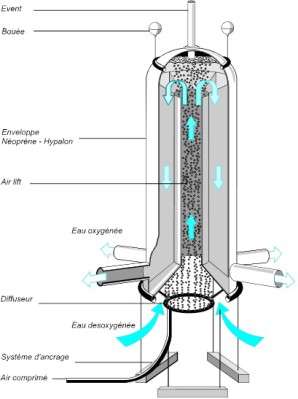
In continental water bodies Eutrophication phenomenonis self-sustaine by the solution of Phosphorus stored in the sediments during anoxic episodes.
The objective of Hypolimnetic aerator LIMNO® is to maintain a dissolved oxygen content inside the hypolimnion above 4-5 mg/l (thereshold of release of reduced compounds).
In addition to improvement of the lake's ecosystem through oxygenation of the bottom layers of the water body, LIMNO® allows :
Maintaining a dissolved oxygen content of more than 5 mg/l at the bottom of the reservoir allows:
This patented device consists of a ten meter high dome made of flexible material. This structure is confining the oxygenation process to avois any break of the thermocline water body.
The water circulation inside the device is managed thru an air lift pump process.
This device is installed on the lake bottom inside the hypolimnion water body. The LIMNO is fed with compressed air by a compressor installed on the shore bank.
The calculation of a hypolimnetic aeration plant is not only based on the oxygen demand of the hypolimnion but alos residual oxygen content inside the hypolimnion water and its renewal. The LIMNO® hypo limnetic aeration plant is specially designed to prevent any thermal mixing of cold deep water with warmer surface water.
LIMNO® acts like a large air lift pump, working by the ascent of an intimate blend of air bubbles and water of lower density than water.
The compressed air is fed under pressure through a primary diffuser placed on the basement device .
The air bubbles are rising along the central chimney of the unit and are carrying a huge volume of water by air lift effect .
Collected waters are simultaneously oxygenated by contact with the bubbles during their ascent. Flow returns downwards through double peripheral partitions, before being horizontally discharged to the outside through nozzles at highspeed.
The air excess, undissolved, escapes from the water through a top vent over the unit, which passes through the thermocline and opens onto the surface of the lake.

In order to increase LIMNO’s efficiency, these units can be equipped with a secondary diffuser (not shown in the diagram) installed at the basement of the double partitions, above the discharge nozzles.
Countercurrent air bubbles are diffusing slowly into the downward flow of water, increasing the contact time between air and water, and consequently increasing the oxygenation capacity of the unit.